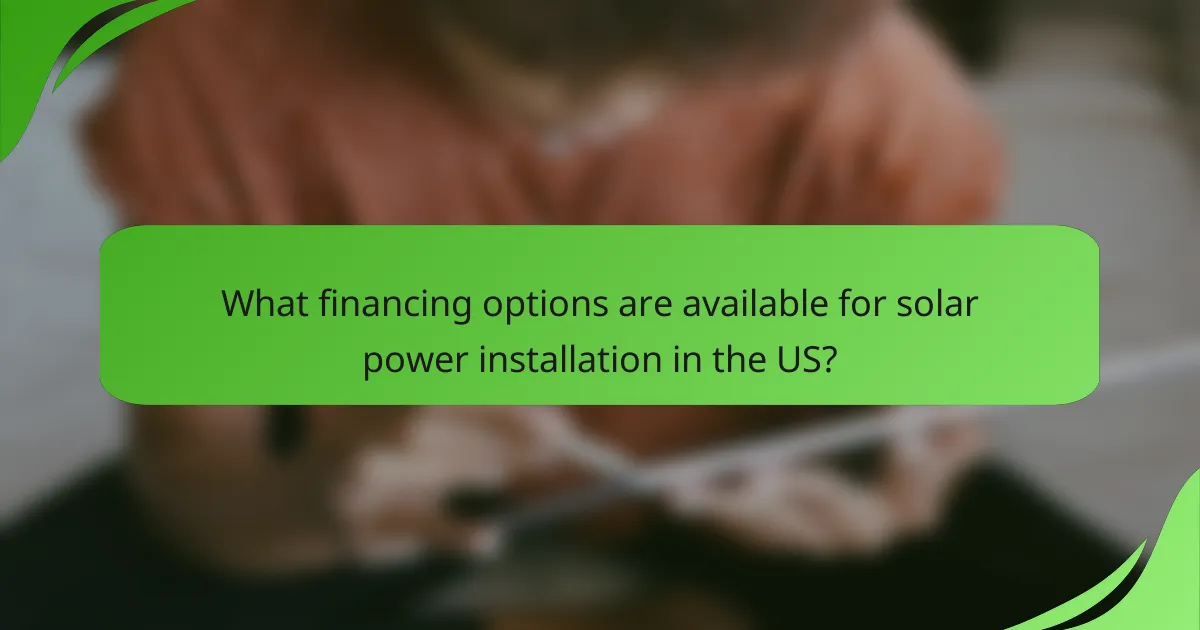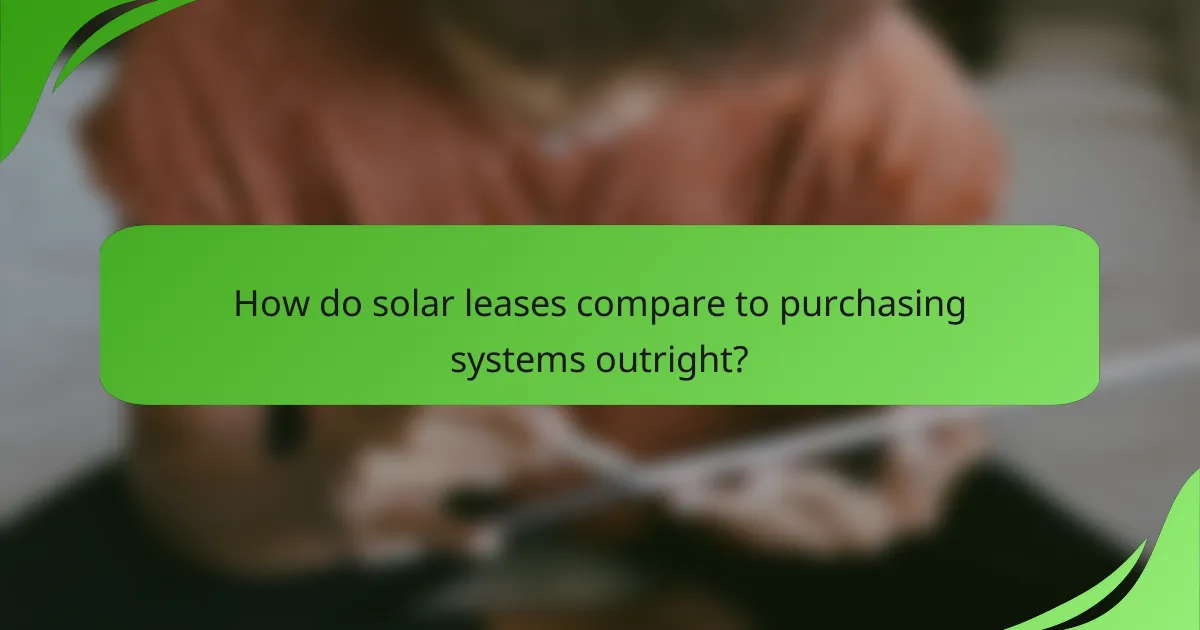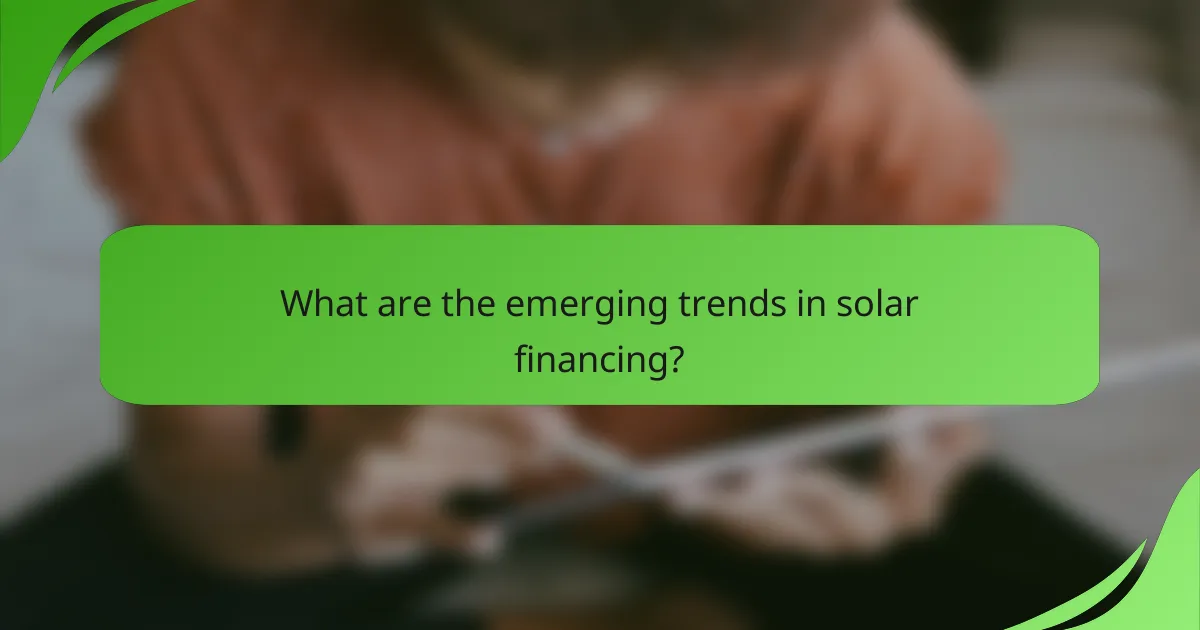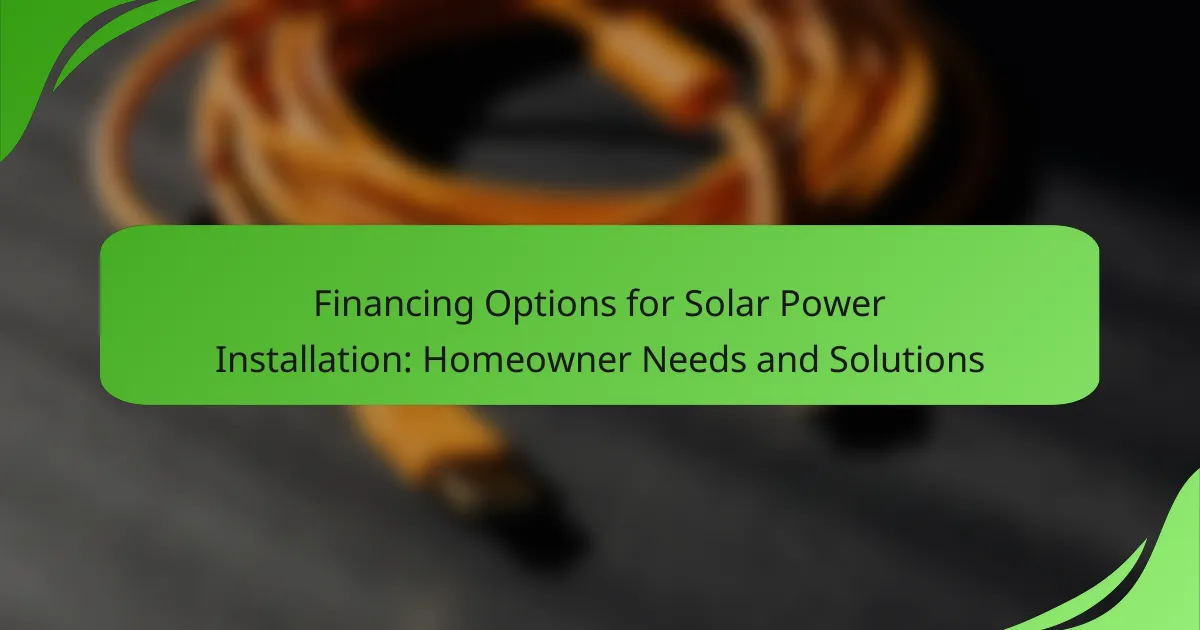Homeowners looking to install solar power have a variety of financing options available to them, including federal tax credits, state incentives, solar loans, leasing options, and Power Purchase Agreements (PPAs). Each financing method offers unique benefits and considerations, making it crucial for homeowners to assess which option best suits their financial circumstances and energy objectives.

What financing options are available for solar power installation in the US?
Homeowners in the US have several financing options for solar power installation, including federal tax credits, state incentives, solar loans, leasing options, and Power Purchase Agreements (PPAs). Each option has its own benefits and considerations, making it essential to evaluate which aligns best with your financial situation and energy goals.
Federal tax credits
The federal government offers a tax credit for solar energy systems, allowing homeowners to deduct a significant percentage of the installation costs from their federal taxes. As of 2023, this credit is set at 30%, providing substantial savings for those who qualify.
To take advantage of this credit, homeowners must ensure their solar system meets specific requirements, including being installed on their primary residence. It’s advisable to consult a tax professional to understand how this credit can impact your overall tax situation.
State incentives
Many states provide additional incentives for solar power installation, which can include rebates, tax credits, and performance-based incentives. These incentives vary widely by state, so it’s crucial to research what is available in your area.
For example, states like California and New York offer robust programs that can significantly reduce upfront costs. Homeowners should check their state’s energy office or local utility for specific programs and eligibility requirements.
Solar loans
Solar loans are a popular financing option that allows homeowners to borrow money to pay for their solar installation. These loans can be secured or unsecured, with terms typically ranging from 5 to 20 years.
When considering a solar loan, homeowners should compare interest rates and terms from various lenders. Some loans may offer low or no interest for a limited time, making them an attractive option for financing solar projects.
Leasing options
Leasing solar panels allows homeowners to install solar energy systems with little to no upfront costs. In this arrangement, a third-party company owns the solar system and the homeowner pays a monthly lease fee.
While leasing can reduce initial expenses, homeowners do not receive the federal tax credit or any state incentives. It’s essential to calculate the long-term costs versus benefits to determine if leasing is the right choice for your financial situation.
Power Purchase Agreements (PPAs)
Power Purchase Agreements (PPAs) are similar to leases but focus on the energy produced rather than the equipment itself. Homeowners agree to purchase the electricity generated by the solar system at a predetermined rate, which is often lower than their current utility rates.
PPAs typically require no upfront payment, making them an appealing option for those who want to go solar without significant initial investment. However, like leasing, homeowners miss out on tax credits and incentives, so it’s vital to assess the overall financial impact before proceeding.

How do federal tax credits work for homeowners?
Federal tax credits for homeowners reduce the overall cost of solar power installation by allowing them to deduct a percentage of the installation costs from their federal income taxes. This incentive makes solar energy more affordable and encourages the adoption of renewable energy sources.
Investment Tax Credit (ITC)
The Investment Tax Credit (ITC) is a federal program that allows homeowners to claim a tax credit for a portion of their solar installation costs. As of 2023, the ITC offers a credit of 30% of the total installation expenses, which can significantly lower the upfront financial burden of going solar.
Homeowners can apply the ITC to their federal tax return, which can result in substantial savings. For example, if a solar installation costs $20,000, the homeowner could receive a tax credit of $6,000, making the net cost more manageable.
Eligibility requirements
To qualify for the ITC, homeowners must meet certain eligibility criteria. The solar energy system must be installed on residential property and must be new or being used for the first time. Additionally, the system must be operational by the end of the tax year for which the credit is claimed.
Homeowners should also ensure that the solar installation meets the necessary safety and performance standards, which are typically verified by local regulations. It’s advisable to consult with a tax professional to confirm eligibility and maximize potential savings through the ITC.

What are the benefits of solar loans for homeowners?
Solar loans offer homeowners a way to finance their solar power installations without the burden of high upfront costs. By spreading the expense over time, these loans make solar energy more accessible while allowing homeowners to benefit from energy savings immediately.
Lower upfront costs
One of the primary advantages of solar loans is that they significantly reduce the initial financial barrier to installing solar panels. Instead of paying the full price upfront, homeowners can finance the system, often requiring only a small down payment or none at all.
This approach allows homeowners to install solar systems that can start generating savings on their energy bills right away, effectively offsetting the loan payments. For example, if a solar installation costs around $15,000, a homeowner might only need to pay a few thousand dollars upfront, depending on the loan terms.
Flexible repayment terms
Solar loans typically come with a variety of repayment options, allowing homeowners to select terms that best fit their financial situation. Loan durations can range from a few years to over a decade, with monthly payments that can be adjusted based on the homeowner’s budget.
Homeowners should consider the trade-offs between shorter and longer loan terms. Shorter terms may have higher monthly payments but lower overall interest costs, while longer terms can ease monthly cash flow but increase total interest paid. It’s crucial to compare different loan offers and understand the total cost of financing before making a decision.

What should homeowners consider when choosing a solar financing option?
Homeowners should evaluate several key factors when selecting a solar financing option, including interest rates, loan terms, and the potential impact on property value. Understanding these elements can help ensure that the financing aligns with their financial situation and long-term goals.
Interest rates
Interest rates significantly affect the overall cost of financing solar installations. Homeowners should compare rates from different lenders, as they can vary widely, typically ranging from low single digits to high teens in percentage terms. A lower interest rate can lead to substantial savings over the life of the loan.
Additionally, consider whether the rate is fixed or variable. Fixed rates provide stability in monthly payments, while variable rates may start lower but can increase over time, potentially leading to higher costs in the future.
Loan terms
Loan terms refer to the duration over which the loan must be repaid, commonly ranging from 5 to 25 years. Shorter terms generally result in higher monthly payments but lower total interest paid, while longer terms can ease monthly cash flow but increase overall costs due to interest accumulation.
Homeowners should assess their financial situation and choose a term that balances affordability with long-term savings. It’s also wise to check for any prepayment penalties that could affect the decision to pay off the loan early.
Impact on property value
Installing solar panels can enhance property value, often by a percentage that reflects the system’s cost and energy savings. Studies suggest that homes with solar installations can sell for more than comparable homes without solar, sometimes adding thousands of dollars to the sale price.
However, the actual impact can vary based on local real estate markets and buyer preferences. Homeowners should consider consulting with real estate professionals to understand how solar financing and installations may affect their specific property value in their region.

How do solar leases compare to purchasing systems outright?
Solar leases provide a way for homeowners to access solar power without the upfront costs associated with purchasing a system outright. While leasing typically involves lower initial payments, buying a system can offer long-term savings and ownership benefits.
Monthly payment structure
With a solar lease, homeowners usually pay a fixed monthly fee for the duration of the lease, which can range from 20 to 25 years. This payment is often lower than the monthly utility bill, making it an attractive option for those looking to reduce energy costs without a large initial investment.
In contrast, purchasing a solar system outright requires a significant upfront payment, which can vary widely based on system size and installation specifics. However, this investment can lead to substantial savings over time, as homeowners can benefit from tax credits and incentives that reduce the overall cost.
Ownership and maintenance responsibilities
When leasing a solar system, the leasing company retains ownership and is responsible for maintenance and repairs. This arrangement can relieve homeowners of the burden of upkeep, ensuring that the system operates efficiently without additional costs.
On the other hand, purchasing a solar system means homeowners take on ownership and all associated responsibilities. This includes maintenance, which can be manageable but may require budgeting for occasional repairs or system upgrades. Homeowners should weigh the benefits of ownership against the potential costs and responsibilities involved.

What are the emerging trends in solar financing?
Emerging trends in solar financing focus on making solar power installations more accessible and affordable for homeowners. Innovative financing options, such as power purchase agreements (PPAs) and community solar programs, are gaining traction, enabling more individuals to invest in solar energy without significant upfront costs.
Power Purchase Agreements (PPAs)
Power Purchase Agreements (PPAs) allow homeowners to install solar panels with little to no upfront cost. Instead, they agree to purchase the electricity generated by the solar system at a predetermined rate, typically lower than local utility prices. This arrangement can lead to immediate savings on energy bills.
Homeowners should consider the length of the PPA, which usually ranges from 15 to 25 years. It’s essential to review the terms carefully, as they can affect long-term savings and the ability to sell the property. Additionally, PPAs may include escalators that increase the rate over time, impacting overall costs.
Solar Loans
Solar loans are another popular financing option, allowing homeowners to borrow money specifically for solar panel installation. These loans can be secured or unsecured, with terms typically ranging from 5 to 20 years. Homeowners can benefit from tax incentives, such as the federal solar tax credit, which can reduce the overall cost of the loan.
When considering solar loans, homeowners should compare interest rates and terms from various lenders. Look for loans with no prepayment penalties, as this flexibility can be beneficial if you decide to pay off the loan early. Be mindful of your credit score, as it can significantly influence the loan terms offered.
Leases and Community Solar Programs
Solar leases allow homeowners to pay a fixed monthly fee to use solar panels installed on their property without owning them. This option can be appealing for those who prefer predictable payments and do not want to manage system maintenance. However, lease agreements can last for long periods, and homeowners may face challenges if they decide to sell their homes.
Community solar programs offer an alternative for homeowners unable to install solar panels on their property. Participants can buy or lease a share of a larger solar array located elsewhere, receiving credits on their utility bills for the energy produced. This approach is particularly beneficial in urban areas where space for solar panels is limited.
